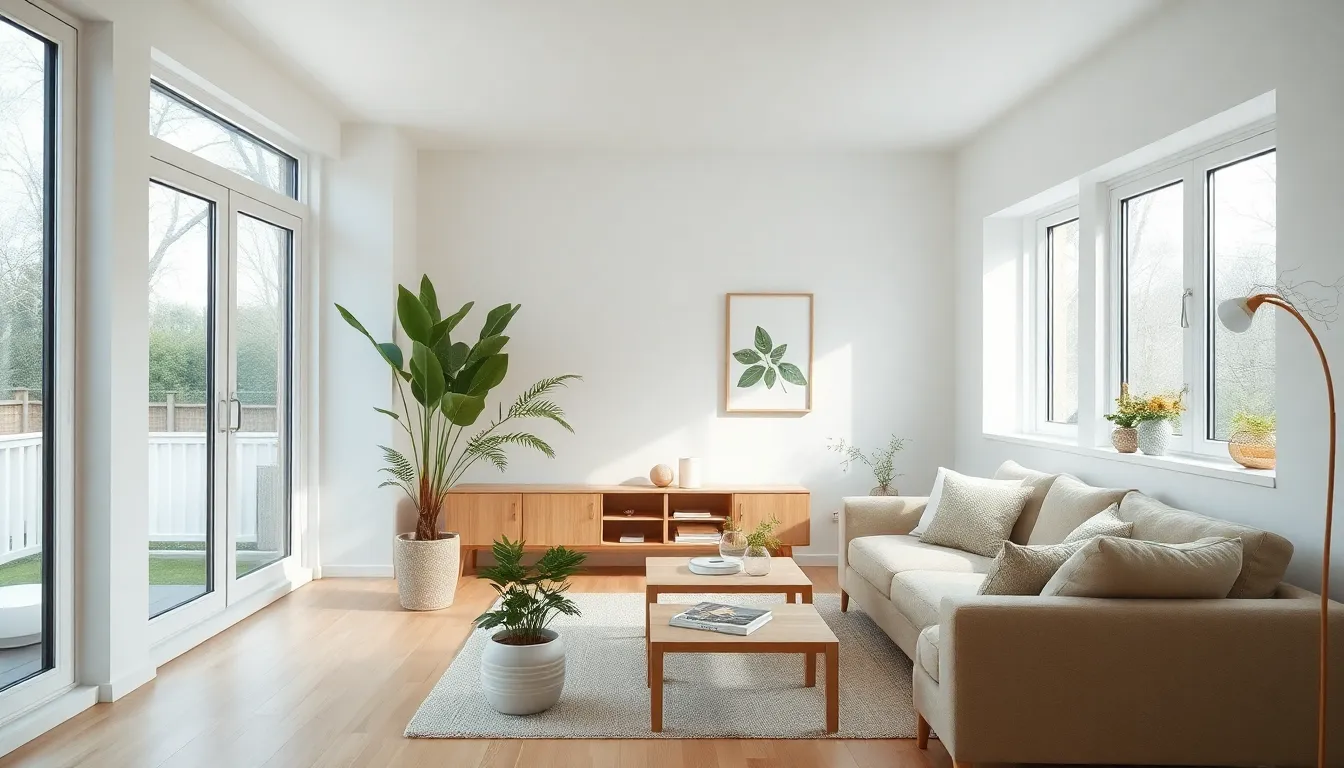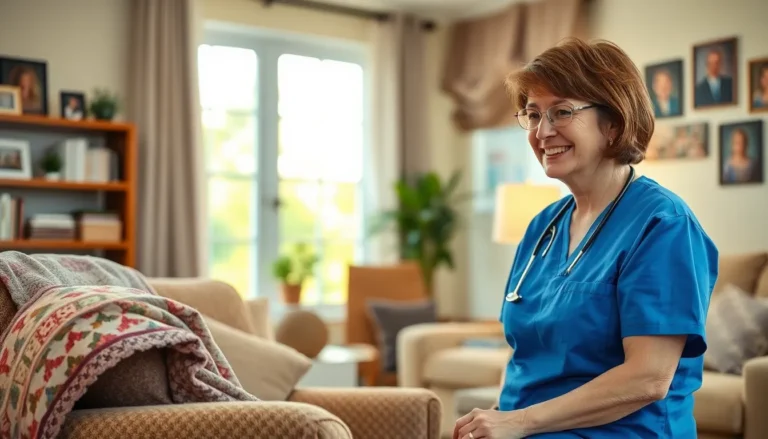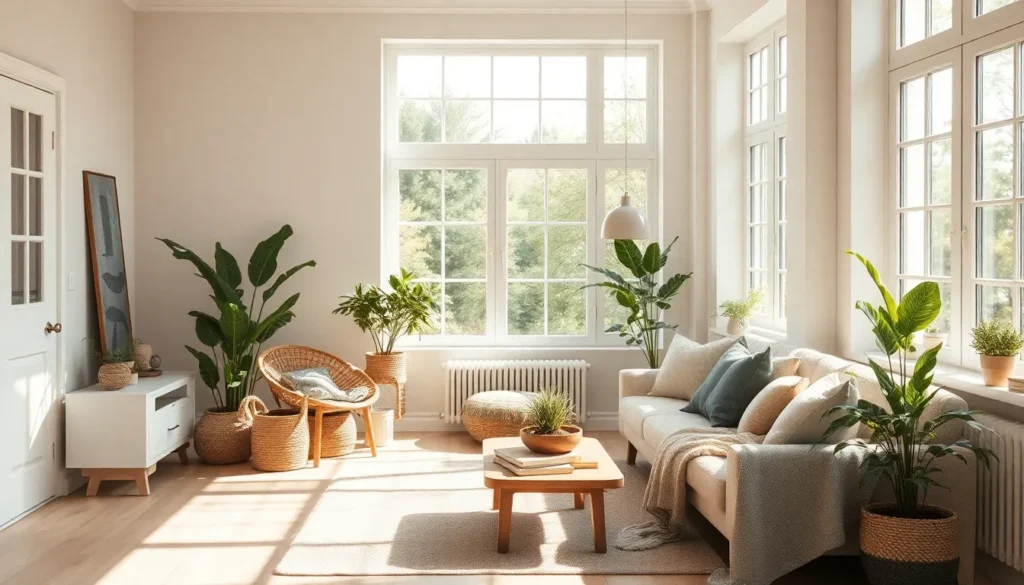Table of Contents
ToggleScandinavian interiors have taken the design world by storm, and for good reason. Imagine a space where minimalism meets functionality, all wrapped up in a cozy blanket of hygge. It’s like stepping into a stylish snow globe—clean lines, soft textures, and just the right amount of warmth to make you feel right at home.
But don’t let the simplicity fool you; this style is anything but boring. With its clever use of natural light and earthy tones, Scandinavian design transforms everyday living into an art form. It’s the perfect blend of form and function, making even the smallest spaces feel vast and inviting. So, if you’re ready to ditch the clutter and embrace a serene sanctuary, dive into the world of Scandinavian interiors—you might just find your new favorite vibe.
Overview of Scandinavian Interiors
Scandinavian interiors center around three core principles: minimalism, functionality, and coziness. This style embraces simplicity, featuring clean lines and uncluttered spaces. Natural light plays a crucial role in creating an airy ambiance, often enhanced by large windows that invite the outdoors in.
Earthy tones dominate the color palette, ranging from soft whites and grays to deep greens and muted blues. Textiles such as wool and linen contribute warmth, while wooden elements — like furniture and flooring — add a touch of nature. These materials not only enhance aesthetics but also promote sustainability, a key aspect of Scandinavian design.
Furniture in Scandinavian interiors prioritizes comfort without sacrificing style. Multi-functional pieces make efficient use of space, making them ideal for smaller living areas. Design focuses on practicality, ensuring that each item serves a purpose while maintaining visual appeal.
Lighting fixtures assume significant importance, often showcasing geometric shapes or organic forms. Pendant lights and floor lamps provide focal points in rooms, creating inviting spaces that encourage relaxation. Additionally, the integration of greenery through potted plants amplifies the connection to nature.
Ultimately, Scandinavian design fosters a serene atmosphere that supports well-being. By emphasizing an uncluttered environment filled with natural materials and light, it transforms living spaces into tranquil retreats. This unique combination resonates with many seeking balance and simplicity in their homes.
Key Characteristics of Scandinavian Interiors

Scandinavian interiors combine simplicity and functionality, creating inviting spaces.
Minimalism and Functionality
Minimalism reigns supreme in Scandinavian design. Spaces feature clean lines and uncluttered layouts. Multi-functional furniture pieces provide practicality for smaller homes. Each element serves a purpose, which enhances the overall efficiency of the layout. Functionality extends to the thoughtful arrangement of objects and furniture, allowing ease of movement. The focus remains on essential items, fostering a serene atmosphere that promotes relaxation.
Natural Materials and Light
Natural materials play a significant role in defining Scandinavian interiors. Wood, stone, and textiles enrich the tactile experience within the space. Light floods through large windows, emphasizing the connection to the outdoors. This abundance of light not only boosts mood but also highlights the beauty of organic materials. Interiors often incorporate plants, connecting the inside with nature. Every choice reflects sustainability and an appreciation for nature’s inherent beauty.
Neutral Color Palettes
Neutral color palettes dominate Scandinavian design. Soft whites, grays, and muted earth tones create a calming backdrop for furnishings. A balance is achieved through subtle contrasts, which add depth without overwhelming the senses. Accent colors, like deep greens and muted blues, occasionally appear, contributing to visual interest. Each color choice complements natural light, enhancing the overall aesthetic. The result is an inviting and tranquil environment that resonates with simplicity.
Popular Scandinavian Design Styles
Scandinavian design encompasses various styles, each with unique characteristics and influences. Understanding these styles enhances appreciation of this aesthetic.
Mid-Century Modern
Mid-century modern design reflects a pivotal era from the 1940s to the 1960s. Characterized by organic forms, clean lines, and functional beauty, it emphasizes simplicity. Furniture features materials like teak and plywood, blending elegance with practicality. Iconic pieces, such as Eames chairs, demonstrate artistry and comfort. Space utilization is efficient, ensuring every element has purpose. Ample natural light, often through large windows, complements this style. Neutral palettes and pops of bold colors create visual interest while maintaining harmony. This style resonates with those seeking classic sophistication alongside modern functionality.
Contemporary Scandinavian
Contemporary Scandinavian design presents a fresh take on traditional aesthetics. Strong emphasis on minimalism underscores current trends in decluttering and simplicity. Designers favor open spaces filled with light, fostering an airy environment. Textures play a vital role, with layers of textiles providing warmth and comfort. Incorporation of smart technology enhances everyday living, integrating convenience into the design. Furniture often boasts sleek lines and innovative shapes, showcasing modern craftsmanship. Earthy tones prevail, with occasional bright accents that add personality. This style captures the essence of current lifestyles, combining aesthetics with everyday functionality.
Essential Elements in Scandinavian Interiors
Scandinavian interiors thrive on a harmonious blend of essential elements. This design style emphasizes simplicity, functionality, and comfort.
Furniture and Decor
Functionality defines furniture in Scandinavian interiors. Multi-functional pieces are common, allowing for efficient space use. Clean lines and minimal ornamentation enhance the overall aesthetic. Materials such as natural wood and soft textiles enrich the tactile experience. Decor often features a few well-chosen accessories that maintain visual harmony. Each selection reflects a commitment to sustainable practices and timeless design.
Lighting and Textiles
Natural light is a central focus in Scandinavian design. Large windows maximize sunlight, creating an airy feel. Lighting fixtures often sport geometric or organic shapes, serving as artistic statements. Soft textiles, including wool and linen, add warmth and comfort. Layering these materials can elevate the coziness factor significantly. A neutral palette typically enhances ambiance while allowing occasional pops of color for interest.
Indoor Plants and Greenery
Integrating greenery fosters a connection to nature in Scandinavian interiors. Potted plants bring life and vibrancy to living spaces. Air-purifying plants, like snake plants and pothos, enhance well-being while maintaining simplicity. Indoor greenery complements natural materials and soft textures. Strategically placed plants can improve air quality and contribute to a tranquil environment. This element showcases a commitment to sustainability and enhances the overall aesthetic.
Scandinavian interiors offer a unique blend of simplicity and warmth that resonates with those seeking a peaceful living environment. By prioritizing natural materials and light, these spaces create a serene atmosphere that enhances well-being. The focus on functionality and minimalism ensures that each element serves a purpose while maintaining aesthetic appeal.
Incorporating elements like cozy textiles and greenery can transform any home into a tranquil retreat. Embracing this design philosophy not only elevates the visual appeal of a space but also fosters a deeper connection to nature. Whether through Mid-Century Modern or Contemporary styles, Scandinavian design continues to inspire and innovate, making it a timeless choice for modern living.







